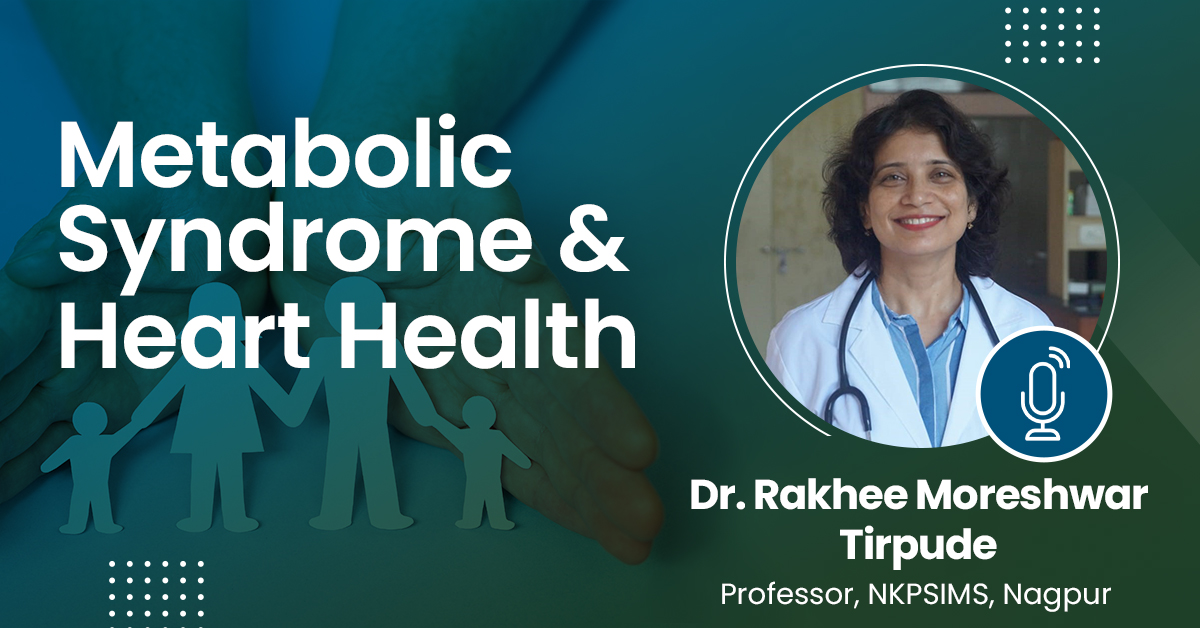- 86k views
Metabolic Syndrome and Heart Health
Metabolic syndrome is a cluster of conditions that increase the risk of heart disease, stroke, and type 2 diabetes. These conditions include high blood pressure, elevated blood sugar, excess body fat around the waist, and abnormal cholesterol or triglyceride levels. When these risk factors occur together, they amplify the risk of developing cardiovascular issues. Metabolic syndrome is closely linked to insulin resistance, where the body struggles to use insulin effectively. Lifestyle changes, such as adopting a healthy diet, regular exercise, and weight management, are crucial in managing the syndrome. Early intervention is essential to prevent the progression to heart disease and other complications.
About the Speaker

Dr. Rakhee Moreshwar Tirpude
Professor, NKPSIMS, Nagpur
Dr. Rakhee Moreshwar Tirpude is Health & Wellness Advocate , Disease Management Mentor and also Associate Professor. She is currently working as Associate Professor (Medical Physiology) NKP Salve Institute Of Medical Science & Research. With over 15+ years of her teaching experience she has keen interest in visual science, diabetes & neurophysiology and 8 publications in my credit and also guiding UG Students.
Upcoming Case Discussions
Hyperlipidemia: From Diagnosis to Treatment
Hyperlipidemia is a condition characterized by elevated levels of lipids, such as cholesterol and triglycerides, in the blood, which can increase the risk of cardiovascular diseases. Diagnosis typically involves blood tests measuring lipid profiles, while treatment focuses on lifestyle changes, such as diet and exercise, alongside medications like statins to manage cholesterol levels and reduce cardiovascular risk. Regular monitoring is essential for effective management and prevention of complications.
Acne: Disorders and Treatment Approaches
Acne is a common dermatological condition caused by clogged pores, excess sebum production, bacterial growth, and inflammation. It can manifest as blackheads, whiteheads, papules, pustules, or cysts, often leading to scarring if untreated. Various factors, including hormonal changes, diet, stress, and genetics, influence its severity. Treatment approaches range from topical and oral medications, such as retinoids, antibiotics, and hormonal therapy, to advanced procedures like chemical peels and laser therapy. A personalized skincare regimen, along with lifestyle modifications, plays a crucial role in managing and preventing acne.
Pulmonary Hypertension
Safer alternatives in pain management focus on reducing the reliance on opioids and minimizing the risk of addiction or side effects. Non-opioid medications such as acetaminophen, NSAIDs, and anticonvulsants are increasingly used for managing both acute and chronic pain. Additionally, physical therapy, acupuncture, and cognitive-behavioral therapy are non-pharmacological approaches that effectively address pain without the risks associated with traditional painkillers. For certain cases, interventional procedures like nerve blocks or spinal cord stimulation offer targeted relief while minimizing systemic side effects. These alternatives aim to provide effective pain management while enhancing patient safety and quality of life.
Molecular and Genetic studies in Gynaecological Malignancies
Molecular and genetic studies in gynecological malignancies have revolutionized diagnostics, prognostics, and targeted therapies. Advances in genomic sequencing have identified key mutations in ovarian (BRCA1/2, TP53), endometrial (PTEN, MSI), and cervical cancers (HPV integration, PIK3CA). These findings aid in precision medicine, guiding individualized treatments like PARP inhibitors for BRCA-mutated ovarian cancer. Epigenetic modifications, including DNA methylation and miRNA regulation, further influence tumor progression and therapeutic response. Emerging technologies like liquid biopsies and multi-omics approaches enhance early detection and monitoring. Understanding these molecular pathways is crucial for developing novel therapies and improving survival outcomes in gynecological malignancies.
Management of Postoperative Pain: Best Practices for GP’s
Effective management of postoperative pain is crucial for promoting recovery and preventing complications. General practitioners should start by assessing pain severity using appropriate scales, then tailor the treatment plan based on the patient's medical history and the type of surgery. A combination of pharmacological approaches, such as non-opioid analgesics (e.g., NSAIDs) and opioids when necessary, should be used to minimize pain while reducing the risk of addiction. Multimodal strategies, including physical therapy and non-pharmacological techniques like cold therapy or mindfulness, can further enhance pain relief. Close follow-up is essential to adjust the treatment as needed and ensure the patient's pain is well-controlled.









